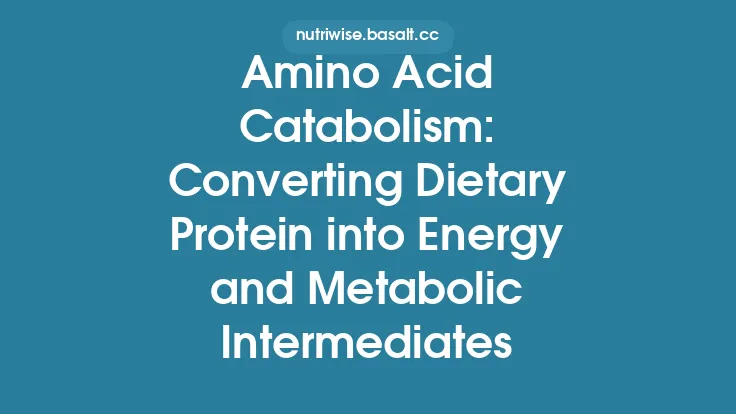Protein quality is a cornerstone of nutrition science, yet it is often misunderstood or oversimplified. While the sheer amount of protein in a food item is easy to quantify, the true value of that protein lies in its amino‑acid composition and how efficiently the body can utilize it. This article delves into the science behind protein quality, explains the most widely accepted evaluation methods, and offers practical guidance for interpreting amino‑acid profiles in everyday food choices.
Understanding Amino‑Acid Profiles
Proteins are polymers of 20 different amino acids, nine of which are classified as essential because the human body cannot synthesize them in sufficient quantities. An amino‑acid profile lists the quantity of each of these 20 residues per gram of protein, typically expressed in milligrams (mg) or as a percentage of the total protein content.
Essential vs. Non‑Essential Amino Acids
| Category | Amino Acids |
|---|---|
| Essential (EAA) | Histidine, Isoleucine, Leucine, Lysine, Methionine, Phenylalanine, Threonine, Tryptophan, Valine |
| Conditionally Essential | Arginine, Cysteine, Glutamine, Glycine, Proline, Tyrosine (become essential under certain physiological stresses) |
| Non‑Essential | Alanine, Aspartic acid, Asparagine, Glutamic acid, Serine |
A high‑quality protein supplies all essential amino acids (EAAs) in proportions that meet or exceed human requirements. When one or more EAAs are present in insufficient amounts, that amino acid becomes the “limiting amino acid,” capping the protein’s overall utility regardless of how abundant the other residues are.
The Concept of a Limiting Amino Acid
Imagine a construction crew that has an abundance of bricks (non‑essential amino acids) but only a few cement bags (the limiting essential amino acid). No matter how many bricks are available, the crew cannot complete the building without enough cement. In nutritional terms, the limiting amino acid determines the maximum amount of protein that can be synthesized from a given food source.
Historical and Modern Methods for Scoring Protein Quality
Over the decades, several scoring systems have been developed to translate amino‑acid profiles into a single, comparable number. Each method incorporates digestibility—how much of the ingested protein actually reaches the bloodstream—as a key factor.
1. Biological Value (BV)
- Definition: The proportion of absorbed nitrogen that is retained in the body for protein synthesis.
- Calculation: BV = (Nitrogen retained / Nitrogen absorbed) × 100.
- Limitations: BV does not account for differences in digestibility across foods and is heavily influenced by the subject’s nitrogen balance at the time of testing.
2. Net Protein Utilization (NPU)
- Definition: The ratio of dietary protein that is retained for body protein after digestion and absorption.
- Calculation: NPU = (Nitrogen retained / Nitrogen intake) × 100.
- Strengths: Incorporates both digestibility and utilization.
- Weaknesses: Requires precise measurement of nitrogen intake and excretion, making it impractical for routine food labeling.
3. Protein Digestibility‑Corrected Amino Acid Score (PDCAAS)
- Development: Introduced by the FAO/WHO in 1991.
- Core Idea: Compare the amount of each essential amino acid in a test protein to a reference pattern (based on human amino‑acid requirements) and adjust for overall digestibility.
- Formula:
PDCAAS = (mg of limiting EAA per g of test protein ÷ mg of same EAA per g of reference pattern) × True Digestibility.
- Capping: Scores are truncated at 1.00 (or 100%) because the method assumes that any excess amino acids beyond the requirement do not confer additional benefit.
- Criticisms:
- Truncation masks differences among high‑quality proteins that exceed the reference pattern.
- Uses fecal digestibility, which can overestimate the amount of amino acids actually absorbed (some are degraded by colonic bacteria).
- Does not differentiate between proteins that are limiting in different EAAs.
4. Digestible Indispensable Amino Acid Score (DIAAS)
- Introduced: FAO 2013 recommendation, intended to replace PDCAAS.
- Key Differences:
- Uses ileal digestibility (measured at the end of the small intestine) rather than fecal digestibility, providing a more accurate estimate of amino acids that become available for metabolism.
- No truncation; scores can exceed 1.00, allowing true differentiation among very high‑quality proteins.
- Evaluates each indispensable amino acid individually, producing a set of digestible indispensable amino acid (DIAA) values.
- Formula:
DIAAS = (mg of digestible indispensable AA in 1 g of test protein ÷ mg of same AA in reference pattern) × 100.
The lowest value among the indispensable amino acids becomes the overall DIAAS for that protein.
- Current Status: While not yet mandated for labeling in most countries, DIAAS is gaining traction in research and industry because of its superior precision.
5. Other Emerging Indices
- Protein Efficiency Ratio (PER): Based on weight gain in growing rats; largely supplanted by human‑centric methods.
- Amino Acid Score (AAS): Simple ratio of each EAA to the reference pattern, without digestibility correction; useful for quick screening but not a complete quality metric.
Interpreting Amino‑Acid Profiles in Practice
When evaluating a food’s protein quality, consider the following workflow:
- Obtain the Full Amino‑Acid Profile
Look for a nutrition label or database entry that lists each of the 20 amino acids per 100 g of food (or per gram of protein). Reliable sources include the USDA FoodData Central, the European Food Information Resource (EuroFIR), and peer‑reviewed food composition tables.
- Identify the Limiting Essential Amino Acid
- Compare each EAA amount to the reference pattern (e.g., the FAO/WHO adult pattern).
- The amino acid with the lowest ratio is the limiting one.
- Apply a Digestibility Correction
- If the source provides a PDCAAS or DIAAS, use that directly.
- If not, consult published ileal digestibility values for the food category (e.g., 95 % for whey, 80 % for soy, 70 % for many legumes after cooking).
- Calculate the Score (if needed)
- For PDCAAS: Multiply the limiting‑AA ratio by the true digestibility.
- For DIAAS: Multiply each EAA amount by its specific ileal digestibility, then compute the ratio to the reference pattern; the lowest ratio is the final DIAAS.
- Contextualize the Result
- Scores ≥ 1.00 (or 100 %) indicate a protein that meets or exceeds human requirements for all EAAs.
- Scores between 0.70–0.99 suggest a good quality protein but may benefit from complementary foods to address the limiting amino acid.
- Scores < 0.70 denote lower‑quality proteins that should be paired with other protein sources for a balanced intake.
Factors That Influence Protein Quality Beyond the Amino‑Acid Sequence
1. Food Processing and Preparation
- Heat Treatment: Cooking can denature proteins, exposing peptide bonds to digestive enzymes and often improving digestibility. However, excessive heat (e.g., over‑roasting) can cause Maillard reactions, binding lysine and reducing its availability.
- Fermentation: Fermented foods (e.g., tempeh, kefir) often exhibit higher digestibility and a more favorable amino‑acid profile because microbial enzymes pre‑digest proteins.
- Mechanical Processing: Grinding or milling reduces particle size, increasing surface area for enzymatic action and typically enhancing digestibility.
2. Anti‑Nutritional Factors
- Phytates, Tannins, and Protease Inhibitors: Common in legumes and whole grains, these compounds can impede protein digestion and reduce the effective availability of certain amino acids, especially lysine and methionine.
- Mitigation Strategies: Soaking, sprouting, and cooking can substantially lower anti‑nutrient levels, thereby improving the functional protein quality.
3. Matrix Effects
The surrounding food matrix (fiber, fat, carbohydrates) can influence the rate and extent of protein digestion. For instance, high fiber can slow gastric emptying, modestly reducing the speed of amino‑acid absorption without necessarily changing total digestibility.
4. Age‑Related Digestive Changes
- Infants and Young Children: Their digestive enzymes are less mature, making them more dependent on highly digestible proteins (e.g., whey, breast milk) with optimal EAA ratios.
- Older Adults: Reduced gastric acid secretion and pancreatic enzyme output can lower protein digestibility, emphasizing the need for proteins with higher intrinsic digestibility or for the use of enzyme‑enhancing preparations.
Practical Applications: Building Balanced Protein Sources
Complementary Protein Pairing
When a single food source is low in a particular essential amino acid, pairing it with another food that supplies that amino acid can create a composite protein of high quality. Classic examples include:
- Cereals + Legumes: Grains are typically low in lysine but high in methionine; legumes are the opposite. Together, they provide a near‑complete amino‑acid profile.
- Nuts + Seeds + Whole Grains: Combining these can offset the modest lysine content of nuts and seeds while delivering a broad spectrum of micronutrients.
Designing a Daily Protein Plan Using DIAAS
- Select Core Protein Foods
- Choose at least one high‑DIAAS source (e.g., whey protein isolate, egg white, fish) to guarantee a robust supply of all EAAs.
- Add Complementary Sources
- Incorporate plant proteins with moderate DIAAS (e.g., soy, lentils) to diversify nutrient intake and provide additional fiber and phytochemicals.
- Balance Across Meals
- Distribute protein intake evenly (e.g., 20–30 g per meal) to maintain a steady supply of amino acids for tissue maintenance and metabolic functions.
- Adjust for Special Populations
- For athletes, older adults, or individuals recovering from illness, prioritize proteins with higher digestibility and a richer leucine content (critical for muscle protein synthesis).
Interpreting Food Labels
- Look for “Complete Protein” Claims – Often indicates that the product contains all nine EAAs in sufficient amounts, but verify the actual amounts if possible.
- Check for “High‑Protein” or “Protein‑Fortified” – These terms do not guarantee high quality; a fortified cereal may have a high protein content but still be limited in lysine.
- Digestibility Information – Some labels now include PDCAAS or DIAAS values, especially for sports nutrition products. Use these numbers as a quick quality check.
Limitations and Ongoing Research
While DIAAS represents the most refined method currently available, several challenges remain:
- Data Gaps: Ileal digestibility values are still lacking for many traditional and emerging foods (e.g., novel plant proteins, insect meals). Researchers are actively expanding databases through human and animal studies.
- Individual Variability: Gut microbiota composition, health status, and genetic factors can modulate protein digestion and amino‑acid absorption, meaning that population‑averaged scores may not reflect every individual’s experience.
- Processing Innovations: New processing technologies (e.g., high‑pressure processing, extrusion) can alter protein structure in ways that are not yet fully captured by existing digestibility assays.
Future directions include integrating metabolomic profiling to track post‑prandial amino‑acid kinetics and developing personalized protein‑quality recommendations based on genetic and microbiome data.
Key Takeaways
- Protein quality hinges on the balance and digestibility of essential amino acids. A protein that supplies all EAAs in adequate proportions and is highly digestible is considered high‑quality.
- DIAAS is the most precise current metric, accounting for ileal digestibility of each indispensable amino acid and allowing scores above 1.00.
- Processing, anti‑nutrients, and the food matrix can significantly modify the effective quality of a protein source, sometimes more than the raw amino‑acid composition.
- Complementary protein strategies enable the construction of complete amino‑acid profiles from lower‑quality sources, a principle especially valuable in plant‑based diets.
- Practical assessment involves obtaining full amino‑acid profiles, identifying limiting amino acids, applying appropriate digestibility corrections, and interpreting the resulting score in the context of overall dietary patterns.
By mastering these concepts, nutrition professionals, food developers, and health‑conscious consumers can make informed decisions that ensure protein intake not only meets quantitative needs but also delivers the highest possible biological value.





